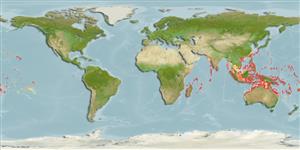分類 / Names
俗名 | 同種異名 | Catalog of Fishes(屬, 種) | ITIS | CoL | WoRMS | Cloffa
Environment: milieu / climate zone / depth range / distribution range
生態學
海洋 礁區魚類; 深度上下限 3 - 44 m (Ref. 90102). 熱帶; 30°N - 33°S, 30°E - 137°W (Ref. 5222)
Indo-Pacific: Kenya south to Natal, South Africa and east to the central Pacific. Unknown from the Red Sea, Persian Gulf, and Hawaii. Recorded from Europa Island (MNHN 1992-0498, Ref. 33390). Often confused with Epinephelus quoyanus, Epinephelus faveatus, Epinephelus corallicola, and Epinephelus howlandi.
印度-太平洋: 肯亞南至南非的納塔爾而且東至中太平洋。 未知的從紅海,波斯灣與夏威夷。 記錄自歐羅巴島了。 (MNHN 1992-0498, 參考文獻 33390) 時常與 玳瑁石斑魚〔Epinephelus quoyanus〕 , 巢斑石斑魚〔Epinephelus faveatus〕 , 黑駁石斑魚〔Epinephelus corallicola〕 與 荷氏石斑魚〔Epinephelus howlandi〕 互相混淆。
大小 / 重量 / 年齡
Maturity: Lm ? range ? - ? cm
Max length : 51.0 cm TL 雄魚/尚未辨別雌雄; (Ref. 4787); 最大體重: 2.0 kg (Ref. 5222)
背棘 (總數) : 11; 背的軟條 (總數) : 15 - 17; 臀棘: 3; 臀鰭軟條: 8. Head profile angular; body less compressed and spots more closely spaced than E. corallicola and E. howlandi (Ref. 37816). Body and median fins with large dark blotches, largest towards the tail (Ref. 48635); further characterized by pale greyish color; head, body and fins with well-spaced dark brown to orange brown spots of unequal size; soft dorsal, anal and caudal fins with narrow white to yellow margin; lower part of head and breast with white blotches; 3-4 black blotches along back; body scales cycloid except ctenoid on lower region below pectoral fins; body with numerous auxiliary scales; greatest depth of body 2.9-3.6 in SL; rounded caudal fin; pelvic fins 1.8-2.4 in head length (Ref. 90102); head length 2.3-2.6 times in SL; flat or slightly concave interorbital area, dorsal head profile of adults with ventral bend at orbits; rounded preopercle, minute serrae mostly covered by skin and shallow indentation just above the angle; straight or slightly convex upper edge of operculum posterior nostril distinctly larger than anterior nostril; maxilla reaches to or past vertical at rear edge of orbit, ventral edge smoothly curved at distal expansion; strongly projecting lower jaw, 2-4 rows of teeth at midlateral part (Ref. 89707).
頭部輪廓有角的; 身體比較不扁長形與斑點更多間隔很密的超過 E. corallicola 與 E. howlandi.(參考文獻 37816) 身體與中央的鰭有大的黑色斑塊, 大的向尾部.(參考文獻 48635)
Found in lagoon and seaward reefs (Ref. 9710) to a depth of at least 44 m; including outer reef slopes. More abundant on oceanic reefs and rare on coastal reefs (Ref. 89707). Feeds on crustaceans (mainly crabs), fishes, octopi, and squid. Solitary (Ref 90102).
發現於潟湖與臨海礁石 (參考文獻 9710) 到深度至少 44 公尺了。 吃甲殼動物 (主要地螃蟹) ,魚,章魚與烏賊。
Life cycle and mating behavior
成熟度 | 繁殖 | 產卵場 | 卵 | 孕卵數 | 仔魚
印度-太平洋: 肯亞南至南非的納塔爾而且東至中太平洋。 未知的從紅海,波斯灣與夏威夷。 記錄自歐羅巴島了。 (MNHN 1992-0498, 參考文獻 33390) 時常與 玳瑁石斑魚〔Epinephelus quoyanus〕 , 巢斑石斑魚〔Epinephelus faveatus〕 , 黑駁石斑魚〔Epinephelus corallicola〕 與 荷氏石斑魚〔Epinephelus howlandi〕 互相混淆。
Heemstra, P.C. and J.E. Randall, 1993. FAO Species Catalogue. Vol. 16. Groupers of the world (family Serranidae, subfamily Epinephelinae). An annotated and illustrated catalogue of the grouper, rockcod, hind, coral grouper and lyretail species known to date. Rome: FAO. FAO Fish. Synop. 125(16):382 p. (Ref. 5222)
IUCN 瀕危狀態 (Ref. 130435: Version 2024-2)
無危 (LC) ; Date assessed: 16 November 2016
人類使用
漁業: 商業性
工具
特別的報告
下載 XML
網路資源
Estimates based on models
Preferred temperature (Ref.
123201): 24.7 - 29, mean 27.9 °C (based on 718 cells).
Phylogenetic diversity index (Ref.
82804): PD
50 = 0.5000 [Uniqueness, from 0.5 = low to 2.0 = high].
Bayesian length-weight: a=0.01072 (0.00699 - 0.01641), b=3.05 (2.93 - 3.17), in cm total length, based on LWR estimates for this species & Genus-body shape (Ref.
93245).
營養階層 (Ref.
69278): 3.8 ±0.5 se; based on diet studies.
回復力 (Ref.
120179): 中等的, 族群倍增時間最少 1.4 - 4.4年 (Preliminary K or Fecundity.).
Fishing Vulnerability (Ref.
59153): Moderate vulnerability (40 of 100).
Nutrients (Ref.
124155): Calcium = 28.4 [13.9, 60.3] mg/100g; Iron = 0.484 [0.265, 0.991] mg/100g; Protein = 18.5 [17.0, 19.9] %; Omega3 = 0.118 [0.074, 0.185] g/100g; Selenium = 32.3 [19.5, 56.8] μg/100g; VitaminA = 189 [53, 675] μg/100g; Zinc = 1.34 [0.94, 1.86] mg/100g (wet weight);
